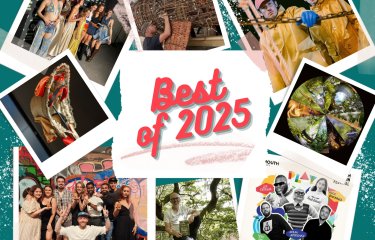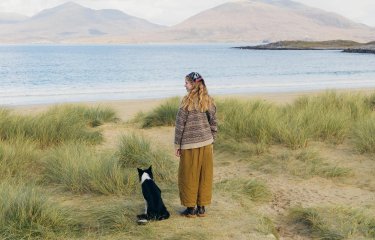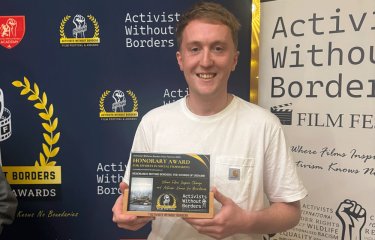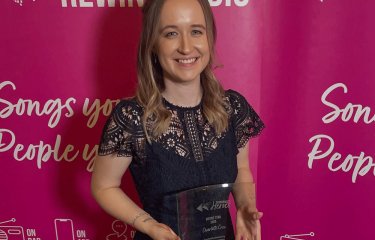From Falmouth University to filming with Sir David Attenborough for Wild Isles
Image credit: Sam Stewart
Image credit: Sam Stewart
Image credit: Sam Stewart
Image credit: Sam Stewart
Image credit: Sam Stewart
Sam Stewart has crafted a truly enviable career since graduating from Marine & Natural History Photography BA(Hons). Here's the latest on his globe-trotting adventures for the likes of the BBC and Netflix, as well as his tips for budding natural photographers.
From traversing the deserts of Oman and the snowfields of Alaska for Netflix and the BBC, to (spoiler alert) filming with Sir David Attenborough for Wild Isles, Sam Stewart has the career many photographers and filmmakers dream of. So, how did he get here? What are his career highlights? And what tips does he have for people who are looking to get into his field of work?
You’ve had a career many of our students dream of when starting university. What made you want to go into wildlife and nature photography/videography?
I grew up fascinated by nature, animals and the outdoors. It wasn’t until I was in my teens that I realised there was actually a chance I could work in this field.
The natural world is in trouble. I want to play my part in helping carve a better future for the earth and her wild places.
I remember watching a behind the scenes section at the end of BBC’s Planet Earth and seeing the camera team on there. I remember realising that it could be me doing that, and I instantly thought to myself, ‘wow that looks like my idea of a perfect job’. I didn’t know anything about the industry then; I was starting from scratch completely, though I had a goal to work on David Attenborough films and just I started chasing it.
It took a few more years, but eventually I saw the Marine & Natural History degree at Falmouth University and it stuck out to me. No other option I had considered anywhere else made me as excited as that course did, and the resulting Open Day I attended sealed the deal!
The natural world is in trouble. I want to play my part in helping carve a better future for the earth and her wild places.
Your projects have seen you travel all over the world. What are the challenges of filming in such varied environments?
Some of the locations I have travelled to for work are simply not designed for humans, cameras or lenses. It can be a recipe for disaster sometimes.
The main challenges are that it’s always different. Every location, every day. There is no routine. Every animal or species is unique and requires their own strategies. Sometimes just keeping the gear alive is borderline impossible, and then the physical aspects of hiking or being out in the elements can make a simple shoot on paper a massive challenge in reality. I have worked in –56°c in northern Canada through to +50°c in Oman.
That’s why I love it though. I love the rewards of capturing things against all odds.
Working with Sir David Attenborough in the field has been my biggest goal since I set out on this path. To see him on my drone controller monitor was incredible. I was certainly relieved when I landed that drone safely!
Your most recent BBC series Wild Isles focuses on wildlife here in the UK. Is filming closer to home a very different experience?
It can be very different. Often people think it must be “way more boring”, however it can also be incredibly rewarding to spend time near home to really appreciate what we have on our doorsteps.
Wildlife in the UK can be very hard to get close to and that takes a lot of field craft, location knowledge and time. All of these factors can be easier if you can be there more regularly, so I love filming and exploring near home. Sometimes the best part of my filming trips abroad is getting back to the UK and hearing the sounds of our songbirds first thing the next day.
Have there been any real 'pinch me' moments from your trips?
There are a few locations that I have been to that have been truly mind blowing. I was part of a very small team that went to the bottom of a volcano crater in the Galapagos called Fernandina. It has been estimated that more people have been to the moon than to the bottom of that crater. It made us all feel small that’s for sure. The raw power of nature there was completely overwhelming.
My most recent ‘pinch me’ moment was being asked to capture Sir David Attenborough for the opening shots of Wild Isles. It was a dream come true. Working with him in the field has been my biggest goal since I set out on this path. To see him on my drone controller monitor was incredible. I was certainly relieved when I landed that drone safely!
Keep saying ‘yes’ to opportunities – you will always learn something. As a mentor of mine once said to me; “a day in the field is never wasted”.
Finally, do you have any advice for aspiring film makers or photographers going into the industry today?
It’s a busy time right now. Wildlife and the climate have never had so much focus, and rightly so: they certainly need it.
The best thing to do in my opinion is to find something you are passionate about and go all in. If that’s long lens camera work, then do what you can to practice follow focus with any lens you have right now. It doesn’t have to be huge, but the skills will be vital going forward.
If you want to go into conservation storytelling, find a story close to home you can work on frequently and start documenting it. Try and be as proactive as possible with realistic goals. Take it step by step and keep pushing. Once you hit a goal then just extend it further.
Once you have a body of work, start sharing it with people that might hire you or could share it on their platform. Keep saying ‘yes’ to opportunities – you will always learn something. As a mentor of mine once said to me; “a day in the field is never wasted”.
See Sam’s latest work on his Instagram




